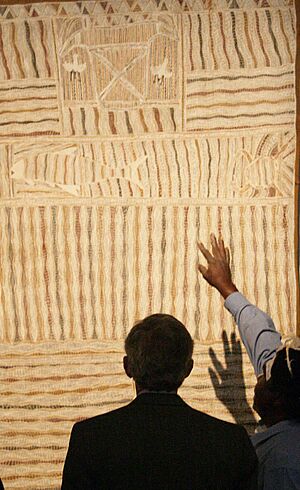Bark painting facts for kids
Bark painting is a special type of Indigenous Australian art. It involves painting on the inside surface of a piece of tree bark. This art form is still very popular today. You can find it especially in Arnhem Land in northern Australia. Many Yolngu people in this area create these paintings. Other parts of the Top End and the Kimberley region also have bark artists.
Long ago, bark paintings were made for teaching and for ceremonies. They were not meant to last forever. But today, these artworks are highly valued. Many art collectors and museums want to own them.
Contents
How Bark Painting Started
The designs you see on real bark paintings are very old. They belong to the artist, their family, or their clan. This means other artists cannot paint these exact designs.
In the past, these designs were used in different ways. People would paint them on their bodies for ceremonies. They also decorated logs used in burial rituals. Painting on flat pieces of bark is a more recent idea. However, there is some proof that artists used to paint designs on the bark walls and roofs of their homes.
The oldest bark paintings we still have are from the 1800s. One example is a bark etching of a kangaroo hunt. It was found near Boort in Victoria. This painting is now in the British Museum.
Modern bark painting began in the 1930s. Missionaries at Yirrkala and Milingimbi asked the local Yolngu people to make them. The missionaries wanted to sell the paintings in cities like New South Wales and Victoria. This helped them earn money for the mission. It also helped teach other Australians about Yolngu culture. As more people wanted the paintings, famous artists like Narritjin Maymuru started having art shows.
It wasn't until the 1980s that bark paintings became known as "fine art." Before that, people often saw them as interesting crafts. Once they were seen as fine art, their prices went up a lot. Today, a good bark painting is valuable for many reasons. It depends on the artist's skill and fame. It also depends on how well the painting tells a traditional story.
How Bark Paintings Are Made
To make a bark painting, you need a few main things. These include paint, brushes, bark, a special fixative, and a fire.
The best bark comes from the Stringybark tree (Eucalyptus tetradonta). The bark needs to be smooth and free of bumps. It's best to cut it from the tree during the wet season. This is when the tree's sap is flowing.
Artists make two cuts across the tree and one cut down. Then, they carefully peel off the bark using a sharp tool. Only the smooth inner bark is kept. This piece is then placed in a fire. After heating, the bark is flattened by foot. Heavy stones or logs are placed on it to help it dry flat. Once it's dry, it's ready for painting.
The paints are made from natural earth pigments, called ochres. These come in red, yellow, and black. Artists also use white pipeclay, which is a type of calcium. Sometimes, they use mineral oxides of iron and manganese for colors.
To make the paints stick, artists use a binder. Today, they might use PVA glue. In the past, they used sap or juice from plants, like orchid bulbs.
After the painting is finished, the bark is strengthened at both ends. This helps keep the painting flat. Finally, a fixative is added over the top. Traditionally, this was orchid juice.
Famous Aboriginal Bark Painters
Many talented artists have created amazing bark paintings. Some of the well-known bark painters include:
- Narritjin Maymuru
- Yirawala
- John Mawurndjul
- Djawa
- Djambawa Murawilli
- George Milpurrurru
- Binyinyuwuy Djarrankuykuy
- Mungurrawuy Yunupingu
- Paddy Dhathangu
- Wandjuk Marika
- Lofty Bardayal Nadjamerrek
- Bobby Barrdjaray Nganjmirra
- Nonggirrnga Marawili
- Nyapanyapa Yunupingu
- Gulumbu Yunupingu
- Jimmy Wululu
See also
 In Spanish: Pintura en corteza para niños
In Spanish: Pintura en corteza para niños


